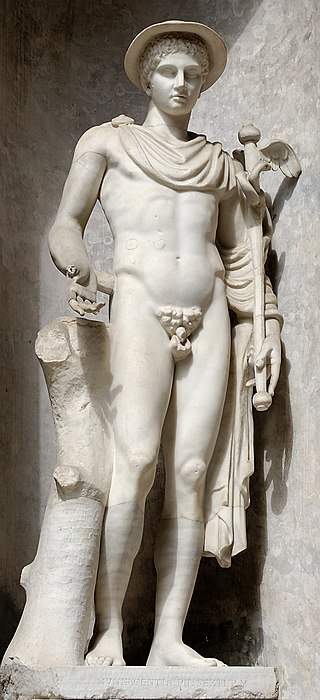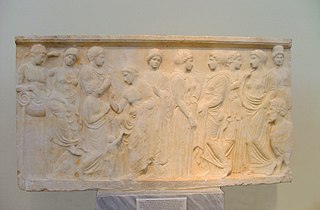
In ancient Greek religion and mythology, Artemis is the goddess of the hunt, the wilderness, wild animals, nature, vegetation, childbirth, care of children, and chastity. In later times, she was identified with Selene, the personification of the Moon. She was often said to roam the forests and mountains, attended by her entourage of nymphs. The goddess Diana is her Roman equivalent.

In ancient Greek religion and mythology, Demeter is the Olympian goddess of the harvest and agriculture, presiding over crops, grains, food, and the fertility of the earth. Although Demeter is mostly known as a grain goddess, she also appeared as a goddess of health, birth, and marriage, and had connections to the Underworld. She is also called Deo. In Greek tradition, Demeter is the second child of the Titans Rhea and Cronus, and sister to Hestia, Hera, Hades, Poseidon, and Zeus. Like her other siblings except Zeus, she was swallowed by her father as an infant and rescued by Zeus.

Hermes is an Olympian deity in ancient Greek religion and mythology considered the herald of the gods. He is also widely considered the protector of human heralds, travelers, thieves, merchants, and orators. He is able to move quickly and freely between the worlds of the mortal and the divine aided by his winged sandals. Hermes plays the role of the psychopomp or "soul guide"—a conductor of souls into the afterlife.

In ancient Greek mythology and religion, Leto is a goddess and the mother of Apollo and Artemis. She is the daughter of the Titans Coeus and Phoebe, and the sister of Asteria.

In Greek mythology, Styx, also called the River Styx, is a goddess and one of the rivers of the Greek Underworld. Her parents were the Titans Oceanus and Tethys, and she was the wife of the Titan Pallas and the mother of Zelus, Nike, Kratos, and Bia. She sided with Zeus in his war against the Titans, and because of this, to honor her, Zeus decreed that the solemn oaths of the gods be sworn by the water of Styx.

Rhea or Rheia is a mother goddess in ancient Greek religion and mythology, the Titan daughter of the earth goddess Gaia and the sky god Uranus, himself a son of Gaia. She is the older sister of Cronus, who was also her consort, and the mother of the five eldest Olympian gods and Hades, king of the underworld.

In ancient Greek religion and mythology, Helios is the god who personifies the Sun. His name is also Latinized as Helius, and he is often given the epithets Hyperion and Phaethon. Helios is often depicted in art with a radiant crown and driving a horse-drawn chariot through the sky. He was a guardian of oaths and also the god of sight. Though Helios was a relatively minor deity in Classical Greece, his worship grew more prominent in late antiquity thanks to his identification with several major solar divinities of the Roman period, particularly Apollo and Sol. The Roman Emperor Julian made Helios the central divinity of his short-lived revival of traditional Roman religious practices in the 4th century AD.

In ancient Greek religion and mythology, the Muses are the inspirational goddesses of literature, science, and the arts. They were considered the source of the knowledge embodied in the poetry, lyric songs, and myths that were related orally for centuries in ancient Greek culture.
In Greek mythology, the Meliae were usually considered to be the nymphs of the ash tree, whose name they shared.

In Greek mythology and religion, Themis is the goddess and personification of justice, divine order, law, and custom. She is one of the twelve Titan children of Gaia and Uranus, and the second wife of Zeus. She is associated with oracles and prophecies, including the Oracle of Delphi. Her symbol is the Scales of Justice.

The Corycian Cave is located in central Greece on the southern slopes of Mount Parnassus, in Parnassus National Park, which is situated north of Delphi. The Corycian Cave has been a sacred space since the Neolithic era, and its name comes from the mythological nature spirits the Corycian nymphs, which were depicted as looking like beautiful maidens and were said to inhabit the cave. More specifically it is named after the nymph Corycia; however, its name etymologically derives from korykos, "knapsack". A modern name for the cave in some references is Sarantavli, meaning "forty rooms" due to the fact that the cave has many caverns that go deep into Mt. Parnassus. The Corycian Cave was used primarily as a place of worship for Pan, the god of the wild, as well as the Corycian nymphs, Zeus, and is also thought to be the ritual home of Dionysus. Also in mythology, Zeus was imprisoned in the Corycian Cave by the monster Typhon.
In Greek Mythology, Eumolpus was a legendary king of Thrace. He was described as having come to Attica either as a bard, a warrior, or a priest of Demeter and Dionysus.
In Greek mythology, Kleodora or Cleodora was one of the prophetic Thriae, nymphs who divined the future by throwing stones or pebbles and were associated with the Oracle of Delphi. She and her sisters Melaina and Daphnis lived on Mount Parnassus, where Delphi is located. With Poseidon, she was the mother of Parnassos, who created a method of telling the future using birds and founded the main city on Mt. Parnassus. Kleodora's father was Cephissus, a river god of northern Boeotia.
In Greek mythology, Melaena or Melena, Melane or Melanis was a Corycian nymph, or member of the prophetic Thriae, of the springs of Delphi in Phocis.
In Greek mythology, Corycia or Corycis (Kōrukis), was a naiad who lived on Mount Parnassus in Phocis.
Lysianassa is the name of four characters in Greek mythology:
In Greek mythology, Thyia was the Naiad-nymph of a spring on Mount Parnassos in Phokis and was a female figure associated with cults of several major gods.
In Greek mythology, Eleusis or Eleusinus was the eponymous hero of the town of Eleusis.

In Greek mythology Cephissus also spelled Kephissos is a river god of ancient Greece, associated with the river Cephissus in Attica and/or with the river Cephissus in Boeotia, both in Greece.
In Greek mythology, Cephalus was a member of the Athenian royal family as the son of Princess Herse and Hermes.











